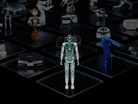AI Humanoid Robots are Here to Revolutionise Manufacturing

For most of modern history, the image of human-like robots working side by side with humans has been a trope of science fiction.
But slowly but surely we're entering an era where this is becoming reality- especially in the manufacturing sector.
The innovation surrounding AI and robots has rapidly increased in the past decade, with these technologies set to dramatically alter labour dynamics and productivity patterns.
Led by innovators like Nvidia, Tesla, Amazon and OpenAI, the market for humanoid robots is projected to grow to a staggering US$38bn by the year 2035.
Driving this growth is the sheer amount of advantages they provide across industries, including manufacturing.
The advantages of humanoid robotics
Rev Lebaredian, the Vice President of Omniverse and Simulation Technology at Nvidia, is a champion of the unique advantages humanoid robots bring.
While specialised robots have their own distinctive benefits, humanoid variants offer a whole new level of flexibility.
For example in warehouses these robots could perform tasks like managing logistics and maintaining continuous production.
Many big manufacturing players are already exploring these applications of humanoid robots.
Tesla has incorporated two Optimus humanoid robots into its production lines with further integrated anticipated by the end of this year.
Elon Musk has expressed that this move may escalate Tesla's market value to US$25tn.
But the value of humanoid robots extends beyond their ability to emulate human-specific tasks.
They also help ensure environments like factories and warehouses continue to be built with human activity and movement in mind.
Speaking at the 2024 World Congress on Innovation and Technology in Armenia, Rev described the humanoid form is being crucial for the successful deployment of these robots.
Their form enables them to integrate seamlessly into existing human-centric infrastructure and environments, removing the need to rebuild or restructure to adapt to differing robot designs.
But this form alone hasn't been enough to power their mass adoption. What the humanoid robot has truly needed is a brain- one that's powered by AI.
AI: The missing ingredient
Rev has described an AI-powered brain as the "missing ingredient" for a useful general purpose robot.
It is AI that will ensure their functionality and versatility, taking humanoid robots from a shiny novelty or a sign of the end times to an integral part of industries like manufacturing. We see this already with companies like Nvidia which utilise the Omiverse platform to enhance the AI learning of their robots in simulations before real-world applications.
"I believe that they're going to become so common, they'll be like our cell phones," Rev says.
“They're going to get cheaper and cheaper very, very quickly."
- The ability to balance, walk and navigate
- Learning from simulations before real-world deployment
- Interacting with their surroundings
Rev's prediction here speaks to the sheer speed of AI development when it comes to humanoid robots.
Partnerships like those between AI firm Figure and OpenAI are a testament to this, developing sophisticated language models for enhanced robot interaction.
Sanctuary AI has also contributed with their development of Phoenix, a robot designed to handle substantial weights, ideal for manufacturing roles.
The prospects ahead
According to Rev, the production costs for humanoid robots are anticipated to decrease significantly, paralleling the cost reduction seen in the smartphone industry.
"Before long, we will be paying little more than the actual manufacturing and material costs for these robots," he says.
This dramatic cost will reduction could facilitate widespread adoption across manufacturing, helping to fill the gaps created by labour shortages and take on dangerous tasks.
Across industries the rise of humanoid robots prompts a range of ethical questions. Which is why as we move closer to this reality across industries like manufacturing, we need open discussion among industry leaders, policymakers and the public.
Either way one thing is clear: With AI, humanoid robots are here - and here to stay.
Make sure you check out the latest edition of Manufacturing Digital and also sign up to our global conference series - Manufacturing & Mobility LIVE
Manufacturing Digital is a BizClik brand
- Jabil & Cyferd: AI-Powered Procurement Boosts ManufacturingProcurement & Supply Chain
- Deloitte Shares 2025 Manufacturing Predictions & OutlookProcurement & Supply Chain
- Hexagon & Microsoft cut Machine Programming Time by 75%AI & Automation
- Capgemini: Leading in Manufacturing AI, Engineering & R&DSmart Manufacturing


